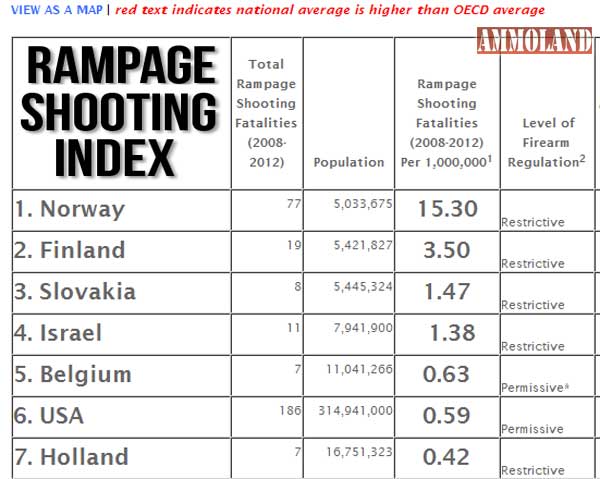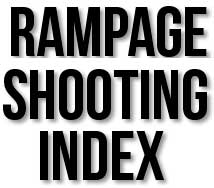from
United States does not lead the world in mass shootings per capita
Obama said this about mass shootings; proven WRONG ...
allenbwest.com/.../obama-said-this-about-mass-shootings-proven-wrong-...
2 days ago - The Rampage Shooting Index assembled data from these countries to construct a per capita mass shootings index that controls for population ...
Chart of Top 10 Nations in the World for Mass Shootings
newyork.craigslist.org/mnh/pol/5082459199.html Boom, here we go: The Rampage Shooting Index. Taken from a now-defunct website, it assembled data from around the world to construct a ...
http://www.ijreview.com/2015/
If You Look at This Chart of Top 10 Nations in the World for Mass Shootings – One Thing Jumps Out
BY KYLE BECKER (24 HOURS AGO) | WORLDetty - Saul Loeb
After the tragic Charleston shooting that left 9 Americans dead, President Obamasaid the following:
But let’s be clear: At some point, we as a country will have to reckon with the fact that this type of mass violence does not happen in other advanced countries. It doesn’t happen in other places with this kind of frequency.
But is that true?
Since most statistics on mass shootings in the world compare apples and oranges by not correcting for population, let’s get a chart that makes sense, shall we?
Boom, here we go: The Rampage Shooting Index. Taken from a now-defunct website, it assembled data from around the world to construct a per capita mass shootings index that controls for population differences.
And since we’re just talking about members of the OECD (Organization for Economic Co-operation and Development), we can assume these 34 countries are sufficiently “advanced” to enter into the discussion.
The bottom line: The United States falls from number one due to its frequency of 38 mass shootings from January 1, 2009 to December 31, 2013 (which would be number one without correcting for population) to number seven.
Security Magazine commented on the data findings:
Between January 1, 2009, and December 31, 2013,there were 413 fatalities from mass shootings in the 34 member states of the Organization for Economic Cooperation and Development (OECD). From the five-year period of 2008-2012, there were 373 total spree shooting fatalities.According to the OECD’s latest version of the Rampage Shooting Index, a pair of deadly shootings in Switzerland in early 2013 pushed the U.S. out of the top five OECD nations for the most per capita fatalities, but the U.S. continues to have the most rampage shooting deaths (one reason could be its size – The U.S. population accounts for 25 percent of the OECD total). However, the U.S. saw a drop in mass shooting deaths from 93 in 2012 to 68 in 2013.
The U.S.’ index of 0.12 per 5,000,000 places it behind Norway (recall the Anders Breivik massacre), Finland, Slovakia, Israel, and Switzerland – at half the ratio.
Another thing one might note: The top 5 countries for mass shootings per capita all have “restrictive” gun policies.
Security Magazine commented on the data findings:
Between January 1, 2009, and December 31, 2013,there were 413 fatalities from mass shootings in the 34 member states of the Organization for Economic Cooperation and Development (OECD). From the five-year period of 2008-2012, there were 373 total spree shooting fatalities.
According to the OECD's latest version of the Rampage Shooting Index, a pair of deadly shootings in Switzerland in early 2013 pushed the U.S. out of the top five OECD nations for the most per capita fatalities, but the U.S. continues to have the most rampage shooting deaths (one reason could be its size -- The U.S. population accounts for 25 percent of the OECD total). However, the U.S. saw a drop in mass shooting deaths from 93 in 2012 to 68 in 2013.
The U.S.' index of 0.12 per 5,000,000 places it behind Norway (recall the Anders Breivik massacre), Finland, Slovakia, Israel, and Switzerland -- at half the ratio.
Another thing one might note: The top 5 countries for mass shootings per capita all have "restrictive" gun policies.
trends:
The five nations suffering the most per capita fatalities from rampage shootings in the OECD were Norway, Finland, Slovakia, Israel and Belgium. Of 34 tracked nations, 17 saw at least one rampage shooting fatality, while the other 17 saw none.
Seven of the ten nations suffering the most per capita fatalities as a result of rampage shootings during the qualifying time period had more psychiatrists, per capita, than the OECD average.
Eight of the ten nations suffering the most fatalities as a result of rampage shootings during the qualifying time period had a per capita, Gross National Income (GNI) higher than the OECD average.
Two-thirds of the 15 nations suffering the most fatalities as a result of rampage shootings during the qualifying time period had more overall World Cup appearances than the OECD average. Meanwhile, two-thirds of the 15 nations suffering the least fatalities had fewer overall World Cup appearances than the OECD average.
All sources used to compile the Rampage Shooting Index are provided, online, at rampageshooting.com to allow researchers and journalists the ability to independently verify the RSI's statistics. Because the RSI uses a crowd-sourced media audit to compile incidences of rampage shootings, members of the public are strongly encouraged to submit reports to the RSI for inclusion in the compendium.
After review, reports of qualified incidents are immediately added to both the RSI's master compendium and tabled statistical index. For more information on the RSI's collection and assessment methodology -- as well as the current version of the compendium and tabled statistical index -- visit rampageshooting.com.
About the Rampage Shooting Index
The Rampage Shooting Index (RSI) tracks incidences of rampage, or spree, shootings in the 34 member states of the Organization for Economic Cooperation and Development (OECD). The RSI collects and analyzes media reports of firearms attacks and applies a five-part criteria to determine if an incident meets a common definition of a "rampage shooting." The RSI is updated annually to cover the preceding, five-year period. The RSI is an independent research project not affiliated with the OECD. Visit: www.rampageshooting.com
Norway, Finland Top List For Most Per Capita Fatalities In 2013 Rampage Shooting Index


USA –-(Ammoland.com)- Version 2.1 of the Rampage Shooting Index (RSI) was released today and is available for review at rampageshooting.com.
The crowd-sourced compendium of international media reports tracks incidences of rampage and spree shootings across the 34 member nations of the Organization for Economic Cooperation and Development (OECD).
The current version covers the time period 2008 through 2012 and notes the following facts and trends:
- The five nations suffering the most per capita fatalities from rampage shootings in the OECD were Norway, Finland, Slovakia, Israel and Belgium. Of 34 tracked nations, 17 saw at least one rampage shooting fatality, while the other 17 saw none.
- Seven of the ten nations suffering the most per capita fatalities as a result of rampage shootings during the qualifying time period had more psychiatrists, per capita, than the OECD average.
- Eight of the ten nations suffering the most fatalities as a result of rampage shootings during the qualifying time period had a per capita, Gross National Income (GNI) higher than the OECD average.
Read more: http://www.ammoland.com/2013/01/norway-finland-top-list-for-most-per-capita-fatalities-in-2013-rampage-shooting-index/#ixzz3dizmwj9w
Under Creative Commons License: Attribution
Follow us: @Ammoland on Twitter | Ammoland on Facebook
Under Creative Commons License: Attribution
Follow us: @Ammoland on Twitter | Ammoland on Facebook

No comments:
Post a Comment